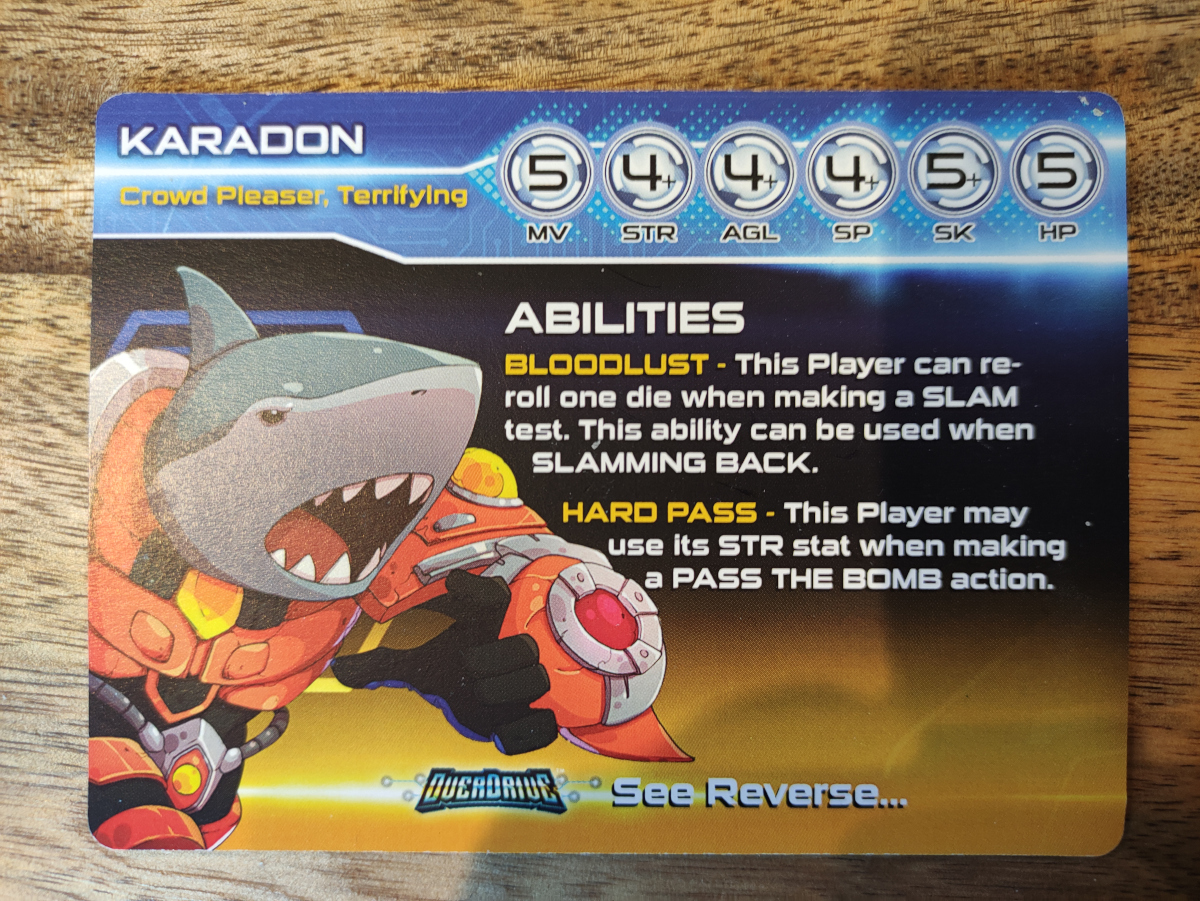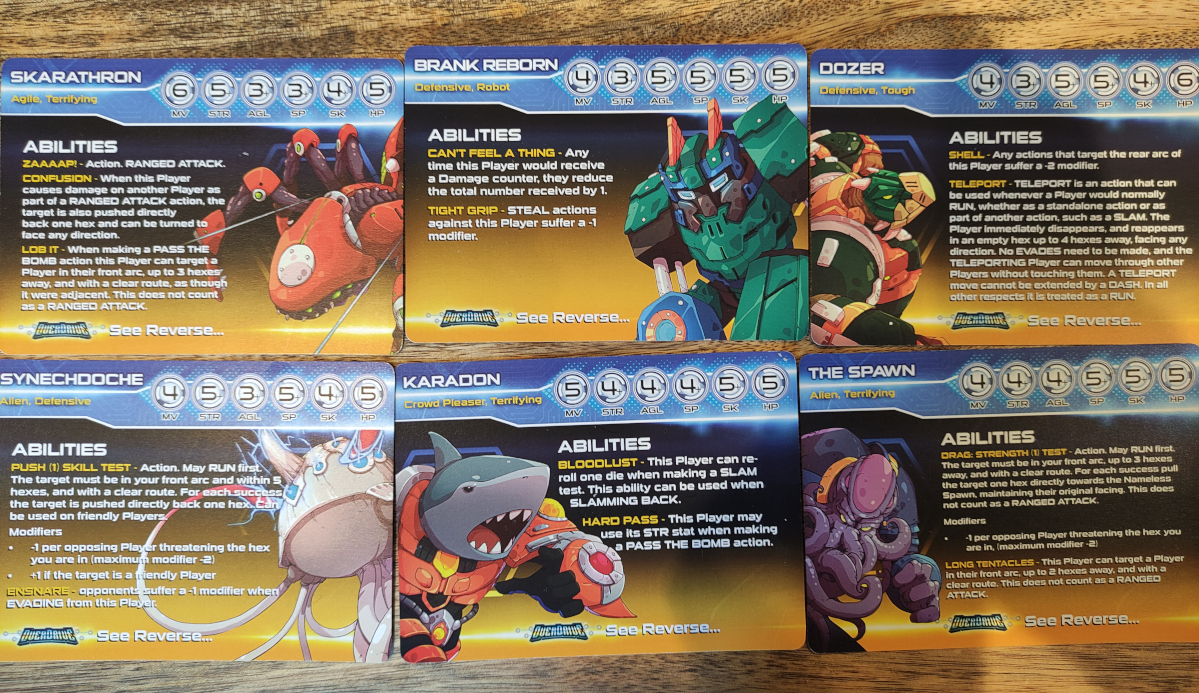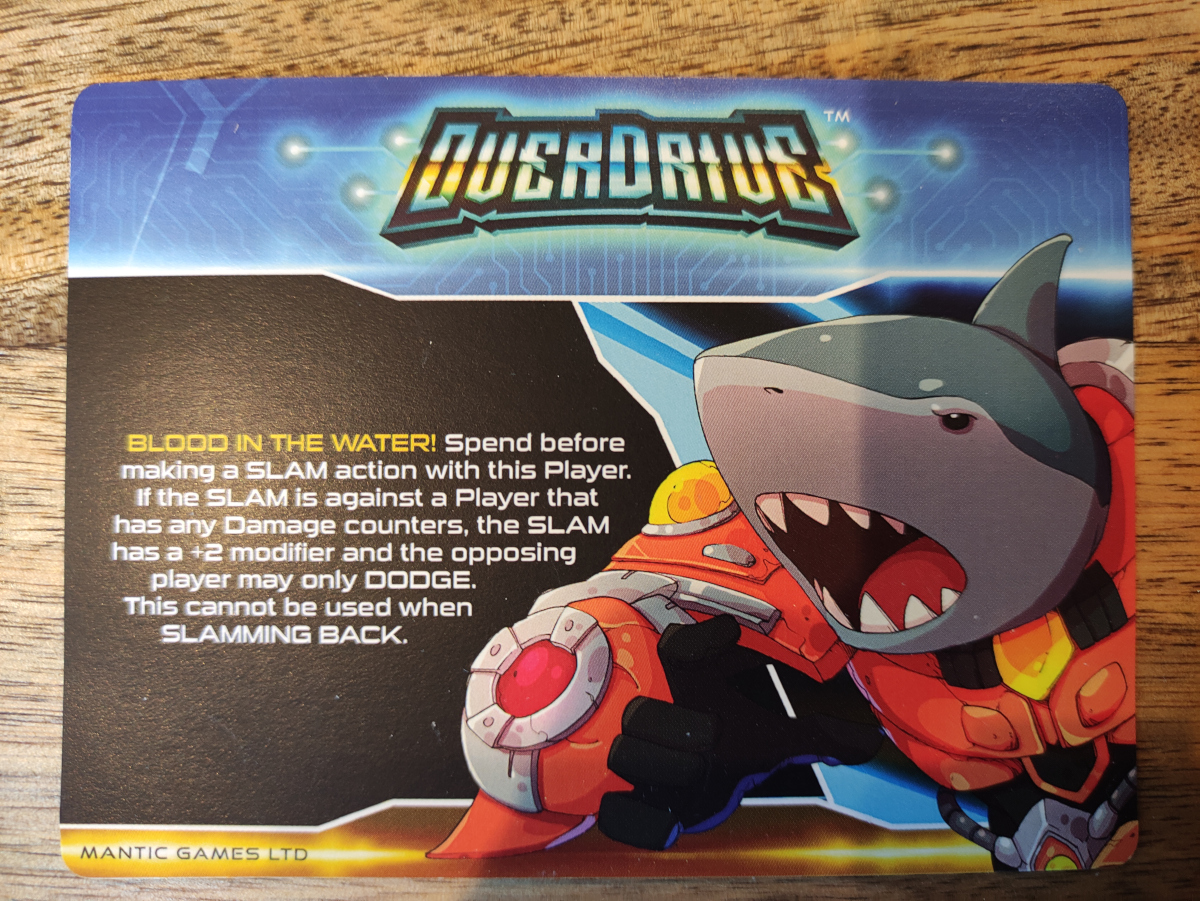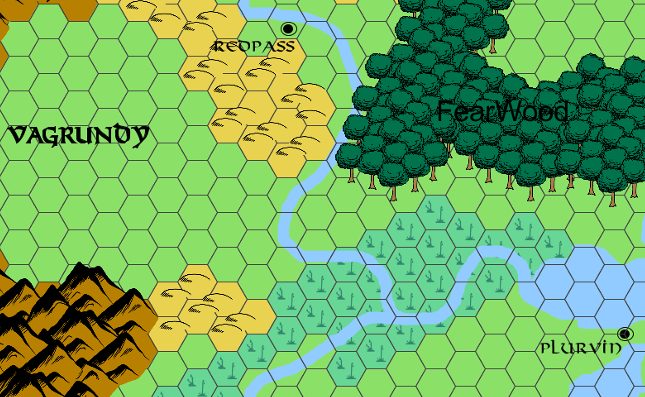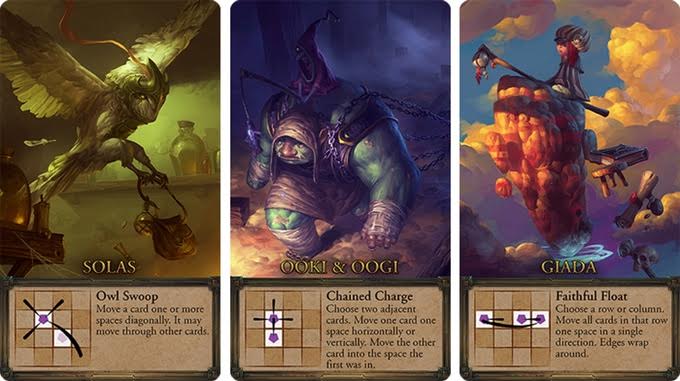There seem to be surprisingly few tabletop sportsball games. Blood Bowl and Blitz Bowl from Games Workshop, Aristeia! from Corvus Belli, and Dreadball from Mantic Games. Mantic is hoping to add this list with its new Dreadball spin-off, Overdrive. Overdrive is an arena combat game that pits teams of huge creatures against one another. The aim is to control the playing zones and mash-up your opponent’s players. The key to success is the timing of your all-important “Overdrive” move.
What Is Overdrive?
Overdrive is a 2-player Arena Combat game, played over 8 rounds or “Rushes.” Each player (coach) uses three different “players” on their team and battles with their opponent to score the most points. Overdrive has several different game modes, but in the basic game, points are scored at the end of each Rush by players that have control of the current (randomly determined) scoring zone.
This is an arena combat game with large-scale miniatures. At the time of writing, there are 6 models from the box, plus an additional two models available from an add-on pack. Models are supplied unpainted and require sticking on their perspex bases. The game is suitable for children around 10 upwards, with games lasting at least an hour. The MRSP is £50 ($75) but you’ll be able to find it cheaper from secondary sellers.
What’s in the Box?
In the box you’ll find:
- 6 Plastic Miniatures
- 6 Player Cards: Double-sided, one for each Player miniature
- 6 Tri-Hex Bases: This is a hex-based game, but not as you know it!
- 12 Six-sided dice: Of impressive quality
- 56-page Rulebook: How to play, as well as alternate game modes and campaign rules
- 63 tokens
- Game board: Single-side, with the arena and player dugout marked on
The components are all of good quality. The models represent the “giants” from Mantic’s Dreadball game, given a new lease on life in a fresh sports franchise. I’ve never played Dreadball so the aesthetic is entirely new to me, but the models have a fun Saturday afternoon sci-fi feel, with tentacles, spider legs, and a giant armored shark.
You’ll need superglue to stick the models to the clear plastic bases. The bases being clear plastic is an interesting design choice. If you use a spray primer, you have to decide if you want to keep the bases clear or make them opaque before you stick the models to the base. What you decide makes little difference to how the game plays. I opted to spray my models including their bases.
One other note about the bases: whilst the board is marked out with hexes, the bases are actually a triangle of hexes. This makes some interesting tactical variation from most hexed-based games. It can also screw with your perspective a little when playing the game. On balance, I like it, but it does take a little getting used to.
It’s worth noting that the players in the additional box are made from resin and require assembly, whilst the models in the core box are plastic and come ready assembled.
How to Play Overdrive
Overdrive takes place over 8 turns. Each turn (rush) is essentially the same, though there isn’t a scoring zone in the first rush.
Models on the pitch are called players and the human players are called coaches.
Setting up the Game
In theory, you randomly select who will be the home and visitor teams, and set up the board accordingly. In all the games I have played so far, we’ve just used the board edge we were sitting at.
Each player is given 4 activation tokens.
Each player is given an overdrive token and places it on the “Charged” space. This token (and space on the board) is almost entirely superfluous, but more on that later.
In a one-off game, players then draft from all of the available Overdrive players in their collection. At the moment this is a total of 8 (6 in the box, with one expansion to add 2 more). Whilst you could use multiple sets to play and use duplicate players on the pitch (with the same players represented on each side, not two in the same team), it is not recommended. We didn’t bother drafting players and just handed 3 out each at random.
The Rush and Score tokens are placed on the board.
The home coach places all of their models on their side of the board. Each player must be placed in a different scoring zone on the pitch but can be placed anywhere within the zone, providing their entire base sits inside the zone. The visiting coach then places their models.
The home coach starts the first Rush.

An Overdrive Turn
There is no active scoring zone in the first turn. This is because it would give one player a significant advantage. It’s time to get stuck in!
The Basics
As I’ve touched on scoring, here is a rundown of the game’s basic rules.
- Scoring: The board has 6 scoring zones. An “Active Scoring Zone (ASZ)” is randomly determined for rushes 2-8. Any model whose base lies wholly within the ASZ at the end of a rush scores a point. If any part of a player’s base covers a bonus scoring hex, two points are scored.
- Points are also scored for taking a player out of action.
- Scoring is tracked using a token that moves along a track, with zero at the center, running to 8 on each player’s side. If any player reaches 8 they automatically win the game. If no player reaches 8 before the end of the 8th rush, the person who has the score counter on their side of the board wins.
- Rushes consist of four actions for each coach. These are distributed between the 3 players on the pitch. After performing an action the player activated is given a token. Each player may receive up to 2 action tokens per rush. Not all players need to be activated during a rush.
- Actions are taken alternately between coaches.
- Once per rush, each coach may use one of their players’ overdrive abilities. These are strong effects that can greatly help you achieve your plans. Execution and timing of an overdrive ability is the key to success.
- Players taken out of action are not removed from the game. Instead, they are placed in a player dugout and will return on the edge nearest their controlling coach at the beginning of the next rush.
The basic rules cover most of the game’s eventualities. There are a few additional rules, such as player arcs, resolving ties, and what to do if you only have one player on the pitch, but I won’t detail them here.
Card Anatomy
Each player has a card associated with them. On one side of this card, you’ll find the player’s stats and standard abilities. On the reverse, you’ll find the details of their Overdrive move.
The stats used in the game are fairly standard tabletop game stats: Movement, Strength, Agility, Speed, Skill, and Health Points.
Movement and Health Points are absolute values. If Health Points are reduced to zero a player is knocked out. Players that are knocked out aren’t eliminated from the game. They’re moved to the KO zone, waiting to return to the fray at the start of the next Rush.
“Movement” is the number of hexes a model can move. Because the players are based on tri-hexes, this raises some movement possibilities that are different from the norm. Models can rotate to face any direction without using a movement point. If the model pivots on any one of its hexes, then this uses a movement point. Essentially, if any of the tri-hexes of the base moves into a new hex, a movement point is used up.
All the other values are X+. This gives the value required (on a D6) to successfully use a stat. So a 3+ stat is better than a 5+ stat.
Players’ stats are used in Overdrive’s dice tests.
There are three components to a dice test in the game.
The type of test (e.g. Ranged Attack), the player’s stat used to make the test, e.g. Skill, and the success criteria for the test. This is the number of successful dice rolls needed to pass the test. So players with a skill of 4+ would pass a Skill test (1) if they one dice rolled scored 4 or more.
Success criteria can be given by either a single number (as outlined above), an ‘X,’ which denotes an opposed roll against the opposing coach, or “(123).” (123) tests are special tests where the first attempt requires 1 success, the second attempt, 2 successes, and the final attempt, 3.
A base test usually uses 3d6.
The tests use an exploding d6 mechanic. If you roll any 6s in your initial roll, you can reroll any and all of them to try to get additional successes. If you roll more 6s, you can keep rolling until you no longer roll 6s. You can get a crazy number of successes with an exploding D6!
The other neat mechanic for making tests is that if your Skill score is 4+, it will always be 4+. Modifiers don’t change the number you need to roll. Instead, they change the number of dice you roll. If effects in play mean that you have a +1 or -1 modifier, this means you add or remove a die from your dice pool. This makes it much easier to remember your player’s stats. For each test, you build your dice pool (which always starts out as a base of 3) and then sling the dice knowing exactly what you need to roll. It’s much more intuitive than games that continually buff and debuff models’ stats.
In Game Actions
As already stated, each coach will make 4 actions with their players during a turn. What is an action?
Like many games (including my beloved Warhammer Underworlds), there are several different types of action that can be made.
There are three main actions.
Run:
Essentially, moving. You can move the number of hexes up to your movement allowance as outlined above. Note: even turning on the spot is a run action. Players can move in any direction, they don’t have to turn if they don’t want to. If players want to move further than their movement stat they can attempt to “Dash.”
This is done using a Dash test which uses the speed stat. It’s a Speed (123) test, which means that you can attempt to move up to three extra hexes (tests are made one after the other.) For the first extra hex, you need one success, then two, then three. Failure at any point brings the Dash to an end and causes a point of damage to the player. A well-executed Dash can snatch victory from the jaws of defeat.
Sometimes you might need to move into a hex adjacent to a player from the opposing team. You can’t just run past people risk-free in Overdrive. In this case, you have to take an Evade test. This is Agility (123), so the more times you move into hexes that are adjacent to an opposing player the harder evading them becomes.
Slam:
A Slam is the meat of the game. It’s how you fight. It’s important to note that a Slam can consist of a Run and then the Slam itself. You don’t have to move into position then attack using two separate actions. If you’re already in position you just slug away.
A Slam is an opposed test. Opposing Players can choose to dodge out of the way or Slam back. If both players Slam, both players make strength tests and compare the results. The winning coach may move the opposing player backward one hex and then move into the resulting space (if they want to). The difference in the number of successes also determines the damage dealt to the opposing player. If one player rolled two successes and the other rolled 0, then the losing player would take two damage. If they’re reduced to zero health, they’re temporarily removed from the board as outlined above.
If the Slam is a draw nothing happens.
For some fighters, discretion is the better part of valor and it may be necessary to dodge the incoming slam.
In which case, the opposing coach makes a Dodge test. This is an opposed agility test against the attacking player’s strength test. Success means the attack is avoided and that player can dodge one hex away in any direction. If the test is a draw or a failure then the Slamming player wins. (In the case of a draw, the attacker won’t do damage, but they can push the dodging fighter and any special abilities invoked by a successful slam will be initiated.)
Slamming back is not without risk, especially for weaker fighters, but it does give you the opportunity to do some damage or even take out your opponent’s fighters during their own action. There are a few modifiers that can swing things in your favor; most notably, fighters that take a run as part of their Slam get +1 dice.
Ranged Attack
Some fighters have Ranged Attacks on their character cards. They can use these when activated. Like a Slam, a ranged attack can also include a free Run before it is made. Ranged attacks can usually be used up to a range of 7 hexes.
Ranged Attacks are opposed Skill Tests against an opposing player’s Dodge. There are several modifiers, including -1 or even -2 dice for long-ranged attacks and -1 if the player moved before shooting.
Overdrive Actions
Once per rush a coach may use a player’s overdrive action. These are detailed on the reverse of the character card. They are usually very powerful, though not all of them can be used all the time. Some need conditions to be met in order to use them. There are no standard rules for an Overdrive, just follow what it says on the card.
You’re meant to track the use of an Overdrive action using the little Overdrive token on the board. It has two different spaces to put it on, depending if you’ve played your Overdrive move or not. This feels like a totally over-engineered solution. The action tokens have Overdrive on one side only. It’s much easier to put the token on the overdrive side when you use that fighter’s overdrive action and keep the other tokens the other way up for standard actions. We didn’t use the tracking counter at all. The round/action bookkeeping is simple, and it’s rare to lose track of actions/ overdrive actions, even if you don’t use tokens.
The End of a Rush
At the end of the Rush, players wholly in the scoring zone score one point for their team (2 if they are covering a bonus scoring hex). After scoring, all tokens are reset. Knocked-Out players are moved to the subs bench ready to return. The active scoring zone is determined for the next round. This is done by rolling a D6. If the same zone is rolled as used in the current Rush, roll again!
The Rush Counter is moved to next number on the track and we go back to the top to play the next rush. Play ends after 8th rush or if one player gets 8 points in front of the other. In the event of a tie, there are some sudden death rules.
Other Ways to Play Overdrive
There are several other ways to play Overdrive. This includes a comprehensive league system, with equipment, sponsorship deals, and coach abilities. Potentially more interesting are ways to actually change the game of Overdrive itself. Instead of only playing an area control game, you can play Pass the Bomb, Capture the Flag, Killing Streak, and Dodgebrawl variants.
Why Play Overdrive?
Sports games seem to be hard to get right. They feel like they ought to be perfect for translations to the tabletop, but it’s hard to transfer the speed and magic of a sport into a tabletop arena. Things can get bogged down way too easily.
Overdrive is a pretty good attempt. Its fairly simple core mechanics make it easy to pick up. You can be Slamming each other in about 10 mins, from reading the rules and opening the board for the first time (you do have to have stuck your models onto their bases before you start).
I read one review of the game that suggested it wouldn’t appeal to many miniatures games fans because there weren’t very many team-building options (at the time of writing there are only 8 different fighters). I feel this rather misses the point. Yes, there is a section of tabletop players who love to spend ages poring over options and designing the best team, so that victory is one step closer before you’ve even placed down the board, but there are also a large number of board gamers who just want to set up a game and play.
Fewer player options also means that buying into the game is comparatively cheap; you don’t always have to chase new stuff. It also means that for the first time ever you (I) might actually have all the miniatures I own for a game painted!
The drafting mechanic, meaning you don’t know which players you’re going to get before you start, makes the game more appealing to me. You have to work with what you have, within the framework of the game. It enables the game’s mechanics to shine, rather than the depth of preparation you’ve done before you turned up for game night.
I’m not sure I would ever want to play a league of Overdrive, but to be honest there’s almost no game that I would like to take part in a league for. The different game modes, however, are a great addition. It means you can bring a fun variation to game night without having to learn a tranche of new rules or bring multiple sets of figures.
Having said that, for a light game, Overdrive can perhaps outstay its welcome. I’m not sure what it would do for game balance, but I’ve tended to feel like I wanted to finish at the bottom of rush 6, but found myself with 2 more to go. Because players are only knocked out and not removed from the game, play time doesn’t speed up as you go through the game. Often the final rounds in arena combat games are much quicker than the earlier ones because everybody is down to their last models in the fight.
On balance, I like the trihex movement. It adds an extra dimension to what you can do with model placement, though if you’re spatially challenged, like me, it can be a little tricky to get your head around sometimes. The number of times I moved two hexes but only counted one was beyond comical. Nevertheless, this is an interesting idea and spices up a tried and tested format.
If you’re looking for a sports arena game, then Overdrive is a good jumping-off point. It introduces some of core Mantic mechanics, in particular, the excellent “exploding dice” mechanic, a fun but not overpowered way of rewarding rolling 6s. It taps into the joy of rolling a 6 that other games often forget in their attempt to be balanced/ mechanically innovative.
Overdrive is my first Mantic game and based on my experiences of playing it, it certainly won’t be the last.
![]() To subscribe to GeekDad’s tabletop gaming coverage, please copy this link and add it to your RSS reader.
To subscribe to GeekDad’s tabletop gaming coverage, please copy this link and add it to your RSS reader.
Click here to see all our tabletop game reviews.
Disclosure: GeekDad received a copy of this game for review purposes.

